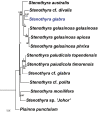Redescription of Stenothyra glabra A. Adam, 1861 (Truncatelloidea, Stenothyridae), with the first complete mitochondrial genome in the family Stenothyridae
- PMID: 33223899
- PMCID: PMC7674392
- DOI: 10.3897/zookeys.991.51408
Redescription of Stenothyra glabra A. Adam, 1861 (Truncatelloidea, Stenothyridae), with the first complete mitochondrial genome in the family Stenothyridae
Abstract
In this study, Stenothyra glabra belonging to the truncatelloid family Stenothyridae is redescribed using morphological characters from the shell, operculum, and radula. The species is distinguished from other species in the group by its shell without spotted spiral lines and by its dome-shaped, mostly smooth, protoconch with some pits. Together with the morphological description, the complete mitogenome for the species is provided, which fill a knowledge gap in Stenothyridae. The mitogenome of S. glabra is 15,830 bp in length and has a circular structure. It contains 37 genes: 22 transfer RNA genes (tRNAs), two ribosomal RNA genes (rRNAs), and 13 protein-encoding genes (PCGs). The overall A+T content of the mitogenome is 68.9%. Molecular phylogenetic analysis and COI sequence divergence separate S. glabra from its congeners and show that S. glabra and S. cf. divalis form a sister clade.
Keywords: Micromollusks; mitogenome; phylogeny; systematics.
Lu Qi, Lingfeng Kong, Qi Li.
Figures



Similar articles
-
New data on the mitochondrial genome of the winter crane fly (Diptera: Trichoceridae) with phylogenetic analysis.Mitochondrial DNA B Resour. 2021 Mar 1;6(2):674-677. doi: 10.1080/23802359.2021.1881839. Mitochondrial DNA B Resour. 2021. PMID: 33763546 Free PMC article.
-
The complete mitochondrial genome of Vanessa indica and phylogenetic analyses of the family Nymphalidae.Genes Genomics. 2018 Oct;40(10):1011-1022. doi: 10.1007/s13258-018-0709-x. Epub 2018 Jun 14. Genes Genomics. 2018. PMID: 29949077
-
Mitochondrial genome of Arcynopteryx dichroa (McLachlan, 1872) (Plecoptera: Perlodidae) and phylogenetic analysis.Mitochondrial DNA B Resour. 2021 Jul 19;6(8):2433-2435. doi: 10.1080/23802359.2021.1955764. eCollection 2021. Mitochondrial DNA B Resour. 2021. PMID: 34350358 Free PMC article.
-
Tanyptera (Tanyptera) hebeiensis Yang et Yang (Diptera: Tipulidae) newly recorded from Shandong, China: sequencing and phylogenetic analysis of the mitochondrial genome.Mitochondrial DNA B Resour. 2021 Jan 13;6(1):115-118. doi: 10.1080/23802359.2020.1848478. Mitochondrial DNA B Resour. 2021. PMID: 33521282 Free PMC article.
-
Characterization of the complete mitochondrial genome of Brentisentisyangtzensis Yu & Wu, 1989 (Acanthocephala, Illiosentidae).Zookeys. 2019 Jul 8;861:1-14. doi: 10.3897/zookeys.861.34809. eCollection 2019. Zookeys. 2019. PMID: 31363345 Free PMC article.
Cited by
-
First record of the genus Conotalopia Iredale, 1929 (Vetigastropoda, Trochidae) in China.Biodivers Data J. 2024 Jun 11;12:e117114. doi: 10.3897/BDJ.12.e117114. eCollection 2024. Biodivers Data J. 2024. PMID: 38903960 Free PMC article.
-
Description of Alvaniawangi Xu, Qi & Kong, sp. nov. (Mollusca, Gastropoda, Littorinimorpha, Rissoidae) from the East China Sea.Zookeys. 2022 Jul 6;1110:201-217. doi: 10.3897/zookeys.1110.82173. eCollection 2022. Zookeys. 2022. PMID: 37588628 Free PMC article.
References
-
- Adams A. (1861) On some new genera and species of Mollusca from the North of China and Japan. Annals and Magazine of Natural History 8: 1–307. 10.1080/00222936108697422 - DOI
-
- Bankevich A, Nurk S, Antipov D, Gurevich A, Dvorkin M, Kulikov AS, Lesin V, Nikolenko S, Pham S, Prjibelski A, Pyshkin A, Sirotkin A, Vyahhi N, Tesler G, Alekseyev MA, Pevzner PA. (2012) SPAdes: A New Genome Assembly Algorithm and Its Applications to Single-Cell Sequencing. Journal of Computational Biology 19: 455–477. 10.1089/cmb.2012.0021 - DOI - PMC - PubMed
-
- Bao YX, Ge BM, Zheng X, Cheng HY, Hu YZ. (2007) Seasonal varlation of the macrobenthic community at East Tidal Flat OF LingKun Island, WenZhou Bay. Acta Hydrobiologica Sinica 36: 189–192. [In Chinese with English abstract]
-
- Benson WH. (1837) Description of the shell and animal of Nematura, a new genus of Mollusca, inhabiting situations subject to alterations of fresh and brackish water. Journal of the Asiatic Society of Bengal 5: 781–782.
LinkOut - more resources
Full Text Sources
Miscellaneous
